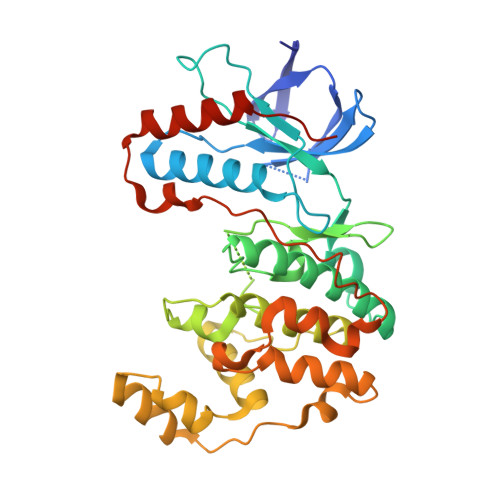Design, Synthesis, and Biological Evaluation of Novel Type I(1)/2 p38 alpha MAP Kinase Inhibitors with Excellent Selectivity, High Potency, and Prolonged Target Residence Time by Interfering with the R-Spine.
Walter, N.M., Wentsch, H.K., Buhrmann, M., Bauer, S.M., Doring, E., Mayer-Wrangowski, S., Sievers-Engler, A., Willemsen-Seegers, N., Zaman, G., Buijsman, R., Lammerhofer, M., Rauh, D., Laufer, S.A.(2017) J Med Chem 60: 8027-8054
- PubMed: 28834431
- DOI: https://doi.org/10.1021/acs.jmedchem.7b00745
- Primary Citation of Related Structures:
5MTX, 5MTY - PubMed Abstract:
We recently reported 1a (skepinone-L) as a type I p38α MAP kinase inhibitor with high potency and excellent selectivity in vitro and in vivo. However, as a type I inhibitor, it is entirely ATP-competitive and shows just a moderate residence time. Thus, the scope was to develop a new class of advanced compounds maintaining the structural binding features of skepinone-L scaffold like inducing a glycine flip at the hinge region and occupying both hydrophobic regions I and II. Extending this scaffold with suitable residues resulted in an interference with the kinase's R-Spine. By synthesizing 69 compounds, we could significantly prolong the target residence time with one example to 3663 s, along with an excellent selectivity score of 0.006 and an outstanding potency of 1.0 nM. This new binding mode was validated by cocrystallization, showing all binding interactions typifying type I 1 / 2 binding. Moreover, microsomal studies showed convenient metabolic stability of the most potent, herein reported representatives.
Organizational Affiliation:
Department of Pharmaceutical and Medicinal Chemistry, Institute of Pharmaceutical Sciences, Eberhard-Karls-Universitaet Tuebingen , Auf der Morgenstelle 8, 72076 Tuebingen, Germany.
















